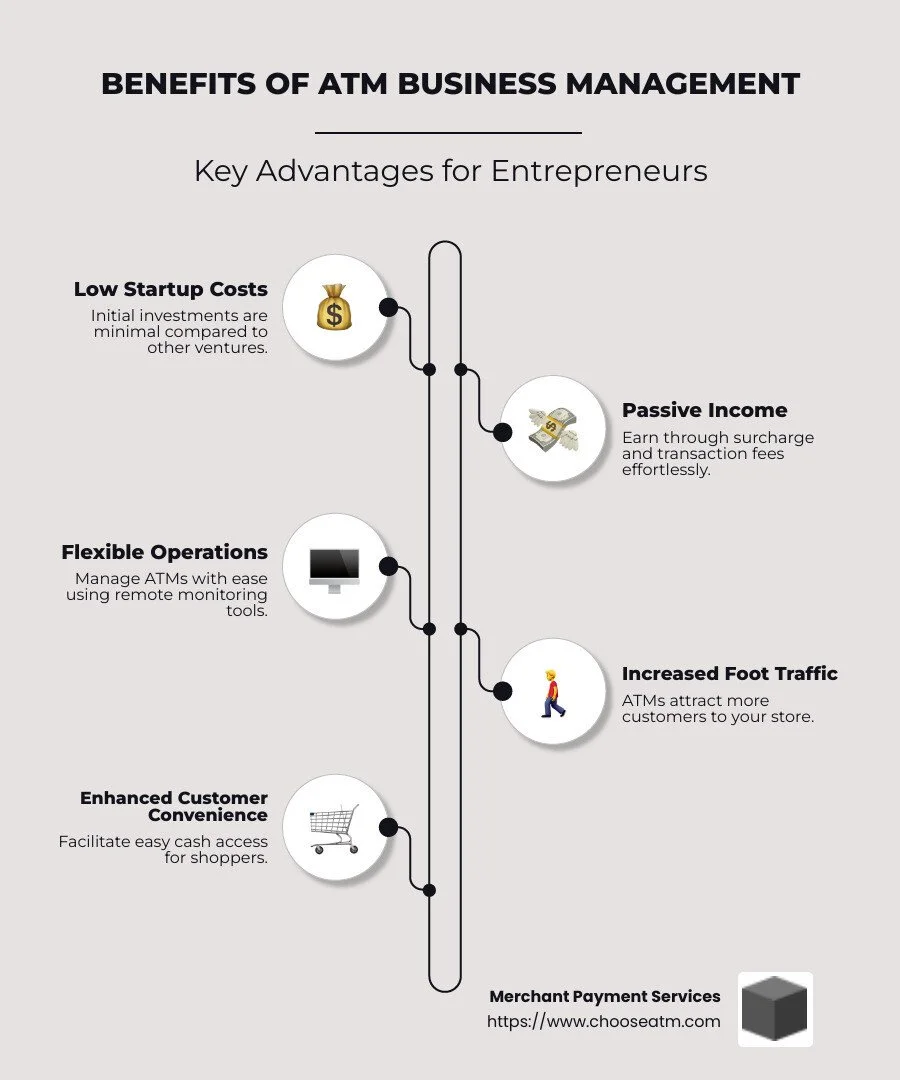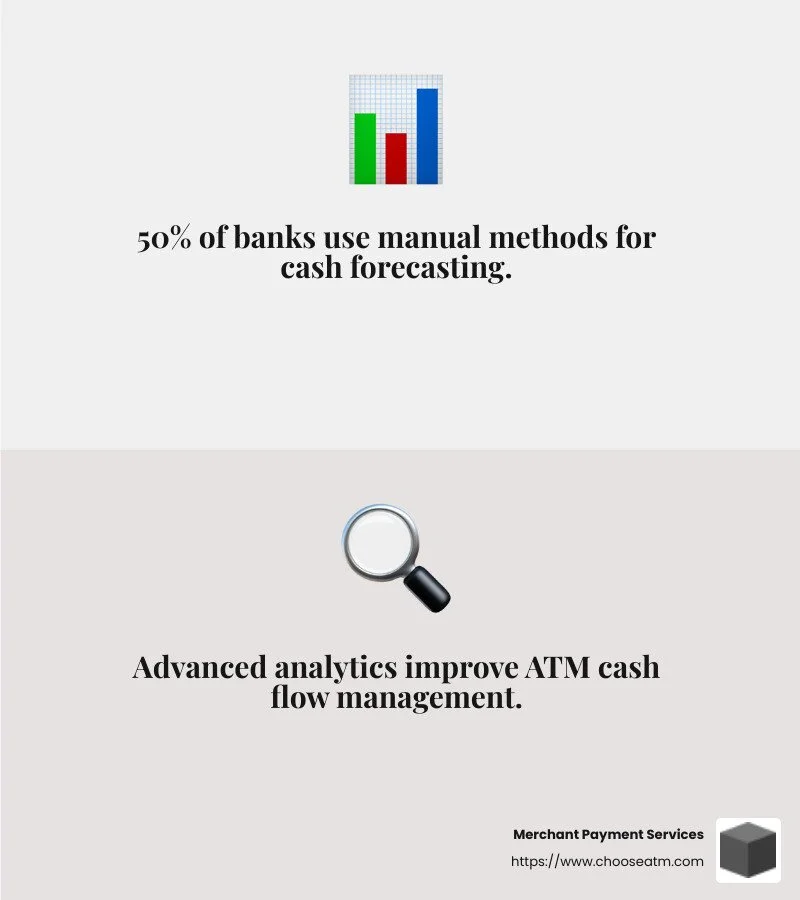Managing Your ATM Business: Strategies for Growth
ATM business management offers a unique opportunity for entrepreneurs seeking passive income with minimal barriers to entry. Low startup costs and promising profitability make it an attractive enterprise for those looking to improve foot traffic and revenue. Here's a snapshot of what ATM business management involves:
Low Startup Costs: Minimal initial investments compared to other businesses.
Passive Income: Earn from surcharge and transaction fees.
Flexible Operations: Easy to manage with remote monitoring tools.
Increased Foot Traffic: ATMs drive more customers into your store.
Many small business owners are drawn to owning ATMs due to these notable advantages. It's a strategic move that not only supplements income through transaction surcharges but also improves customer convenience, encouraging more in-store spending.
As the co-owner of Merchant Payment Services, I'm Lydia Valberg. My background in ATM business management spans over 35 years, emphasizing customer success and seamless operations. My goal is to simplify ATM management for you, ensuring it remains a profitable, hassle-free addition to your business.
Understanding the ATM Business Landscape
Navigating ATM ownership can be a rewarding venture, but it requires a solid understanding of the market and strategic location selection. Let's break down these key aspects to help you make informed decisions.
ATM Ownership
Owning an ATM means you're in charge of its operation and maintenance. This includes ensuring it is stocked with cash, functioning properly, and secured against potential threats. Many entrepreneurs are drawn to this business model because of its potential for passive income. With each transaction, you earn a surcharge fee, which can add up significantly over time.
However, it's crucial to understand the responsibilities that come with ownership. Regular maintenance and cash management are essential to keeping your ATM operational and profitable. Some owners choose to handle these tasks themselves, while others hire third-party services to ensure efficiency and security.
Market Research
Before diving into the ATM business, conducting thorough market research is essential. This involves analyzing the demand for cash in potential locations, understanding competitor presence, and assessing the economic activity of the area.
For instance, a study by McKinsey highlights that nearly half of banks use manual methods to forecast cash needs, which can be inefficient. Advanced analytical tools can offer better predictions and help you manage cash flow more effectively.
Understanding the demographics and spending habits of the local population can also guide your decisions. Are there enough people in the area who prefer cash transactions? Is there a high foot traffic that could lead to frequent ATM use? Answering these questions can help you identify profitable locations.
Location Selection
Choosing the right location is perhaps the most critical factor in ATM success. High-traffic areas like convenience stores, entertainment venues, and tourist spots are ideal. These locations not only ensure frequent usage but also increase the visibility of your ATM.
Consider these two tiers of location selection:
Tier 1 Locations: These are prime spots with high foot traffic and a captive audience, such as busy take-away restaurants or entertainment complexes. They often already have ATMs, making competition tougher, but the potential for high transaction volume is significant.
Tier 2 Locations: These are less obvious but can be valuable for smaller operators. Places like bars, smaller hotels, or local amusement parks may not attract national deployers but can offer steady traffic for a more niche market.
In conclusion, understanding the ATM business landscape involves more than just purchasing a machine. It requires careful planning, strategic location selection, and effective management to maximize profitability. As you start on this journey, the right research and preparation can set the foundation for a successful ATM business.
Next, we'll explore key strategies for ATM business management, focusing on systems and revenue optimization.
Key Strategies for ATM Business Management
Managing an ATM business effectively requires strategic planning and the right tools. Let's explore some key strategies that can help you thrive in this industry, focusing on ATM management systems, cash flow optimization, and boosting surcharge revenue.
ATM Management System
An ATM management system is your best friend in this business. It helps you monitor and control your ATMs remotely, offering real-time insights into their status and cash levels. This system ensures you can address issues quickly, minimizing downtime and enhancing customer satisfaction.
Many banks still rely on manual processes for cash forecasting, which can lead to inefficiencies. An automated management system offers advanced analytics, providing accurate forecasts and helping you manage cash more effectively. This means fewer trips to restock cash and more uptime for your ATMs.
Cash Flow Optimization
Optimizing cash flow is crucial for maximizing your ATM's uptime and profitability. Start by analyzing cash usage patterns to determine the optimal amount of cash to keep in each machine. This prevents running out of cash while avoiding excess, which ties up your funds unnecessarily.
Consider using ATM management software to monitor cash levels remotely. This allows you to plan restocking trips efficiently. For larger operations, partnering with a cash delivery service can ensure timely restocking without straining your resources.
Efficient cash flow management not only keeps your ATMs operational but also improves your overall profitability.
Surcharge Revenue
Surcharge fees are a significant source of income for ATM owners. To maximize this revenue, focus on high-traffic locations where customers are likely to use your ATM frequently. As noted in the research, over 60% of cash withdrawn from ATMs is spent at the same location, making strategic placement crucial.
Negotiating merchant contracts is another way to optimize surcharge revenue. Clearly outline the terms, including the percentage or flat rate of the surcharge that the merchant will receive. This transparency builds trust and encourages long-term partnerships.
Additionally, consider branding your ATMs with clear signage to attract users. Visibility plays a key role in increasing transactions, so make sure your machines are easy to spot and access.
By implementing these strategies, you can effectively manage your ATM business and drive growth. In the next section, we'll explore the setup process, including legal requirements and choosing the right ATM machines.
Setting Up Your ATM Business
Starting an ATM business involves several important steps. Let's break down the essentials: legal requirements, choosing the right ATM machines, and the installation process.
Legal Requirements
Before you can start operating, you need to steer the legal landscape. First, ensure you have a business license for your state or municipality. Some states also require a specific ATM license, so check your local regulations.
If your ATMs will sell goods or services, a sales tax permit might be necessary. And don't forget about ADA compliance. Your machines must be accessible to individuals with disabilities. This includes features like audio guidance or Braille keypads.
Research local laws regarding ATM placement. This includes zoning restrictions, fee limitations, and cash loading regulations. Staying informed about these laws is crucial to avoid legal issues.
Choosing ATM Machines
Selecting the right ATM machines is vital for your business. Look for machines that are EMV-compliant to ensure secure transactions. Avoid the temptation to buy used equipment. New machines come with warranties and are less likely to need repairs, which can be costly and disruptive.
Consider the type of ATM that fits your needs. Basic models dispense cash, while advanced models offer features like check deposits and balance inquiries. Choose machines that align with your business goals and customer needs.
Installation Process
Once you've chosen your machines, it's time for installation. Proper installation ensures your ATMs function smoothly. Connect them to electricity and the internet, if necessary. Configure the software to align with your ATM management system.
Regular maintenance is essential. Schedule routine checks to update software and perform necessary repairs. You can handle this yourself or hire a technician. Keeping your machines in top shape minimizes downtime and keeps customers happy.
Security is another key aspect. Use high-quality vaults, locks, and cameras to protect your ATMs. Work with your locations to ensure site security and consider insurance to cover theft or damage.
By following these steps, you're on your way to setting up a successful ATM business. Next, we'll explore how to maximize growth through effective transaction fee management, merchant contracts, and cash loading strategies.
ATM Business Management: Maximizing Growth
Once you've set up your ATM business, the next step is to focus on growth. Here's how you can do that through transaction fees, merchant contracts, and cash loading strategies.
Transaction Fees: Boosting Your Earnings
Transaction fees are the bread and butter of ATM revenue. Most of the money you earn will come from these fees. Setting the right fee is crucial. Too high, and you might drive customers away. Too low, and you won't cover your costs.
A good rule of thumb is to research what other ATMs in your area charge. Aim to stay competitive while ensuring profitability. That over 60% of cash withdrawn is spent in the same location. This means your ATM not only earns from fees but also boosts sales for the host business.
Merchant Contracts: Building Strong Partnerships
Merchant contracts are agreements between you and the business hosting your ATM. These contracts outline the surcharge revenue split, the length of the contract, and who owns the ATM.
A clear and fair contract benefits both parties. The business gets a share of the surcharge revenue, which can help offset their credit card processing fees. For you, it secures a location and establishes a partnership.
Make sure your contracts are detailed. Include terms like the payout schedule, maintenance responsibilities, and any exclusivity agreements. Consulting with an attorney can help ensure your contracts protect your interests.
Cash Loading Strategies: Ensuring ATM Uptime
Keeping your ATMs stocked with cash is vital. If a machine runs out, not only do you lose potential fees, but you also risk frustrating customers.
Use ATM management software to monitor cash levels remotely. This helps you identify when a machine needs refilling. Consider patterns like weekends or holidays when demand might spike.
Decide whether you'll handle cash loading yourself or hire a cash delivery service. Doing it yourself can save money, but it requires time and effort. A service can be more convenient but comes with additional costs.
By focusing on these strategies, you can effectively manage your ATM business and drive growth. Next, we'll address some common questions about ATM business management to help you steer this exciting venture.
Frequently Asked Questions about ATM Business Management
Is owning an ATM business profitable?
Owning an ATM business can be quite profitable, especially if you choose high-traffic locations. Transaction fees are the main source of income. Typically, these fees range from $2 to $3 per transaction. In busy spots like malls or transportation hubs, a single ATM can generate over $1,000 per month just from fees.
However, profitability depends on several factors. First, location is crucial. The more people passing by, the more likely your ATM will be used. Second, it's important to set competitive transaction fees. If your fees are too high, customers might avoid using your machine.
How much does it cost to own an ATM?
The cost of owning an ATM includes both initial and ongoing expenses. ATM machine costs can vary. A new machine might cost between $2,000 and $8,000, depending on the model and features. Used machines are cheaper but might need upgrades to meet current standards like EMV compliance.
Operational expenses include maintenance, cash loading, and network fees. Maintenance ensures your machine is always working. Cash loading keeps it stocked, and network fees cover transaction processing. On average, these costs can add up to a few hundred dollars per month.
What is an ATM management system?
An ATM management system helps you monitor and control your ATM network efficiently. These systems provide real-time data on cash levels, transaction volumes, and machine status. This information is crucial for data processing and decision-making.
For instance, if a machine is running low on cash, the system alerts you. This allows you to plan refills, minimizing downtime. Additionally, it helps track transaction trends, which can inform your fee strategy or highlight potential new locations.
By using an ATM management system, you can optimize cash flow, reduce operational risks, and improve overall efficiency. This technology is a key part of successful ATM business management.
Next, we'll conclude with how Merchant Payment Services can simplify ATM ownership and improve profits for your business.
Conclusion
Managing an ATM business can seem daunting, but it doesn't have to be. At Merchant Payment Services, we specialize in simplifying ATM ownership and helping you improve your profits. Our solutions are designed to make ATM business management as smooth as possible, so you can focus on growing your income.
Why choose us? With over 35 years of experience, we know the ins and outs of the ATM industry. We offer access to top ATM brands like Nautilus Hyosung and Genmega, ensuring you have reliable and efficient machines. Plus, our expertise in reducing credit card processing fees means more money stays in your pocket.
Boost your revenues: Our ATMs can increase foot traffic to your business and generate surcharge revenue. Did you know that over 60% of cash withdrawn from an ATM is spent right there in the same location? This means our ATMs not only pay for themselves through transaction fees but also boost your sales.
Your trusted partner: We pride ourselves on our commitment to excellence and customer satisfaction. Our mission is to support you every step of the way, from installation to ongoing management. With our help, you can steer the complexities of ATM business management with ease.
Ready to take the next step? Learn more about how we can support your ATM ventures and maximize your profits.
By partnering with Merchant Payment Services, you're not just getting an ATM provider; you're gaining a partner dedicated to your success. Let us help you open up the full potential of your ATM business.



